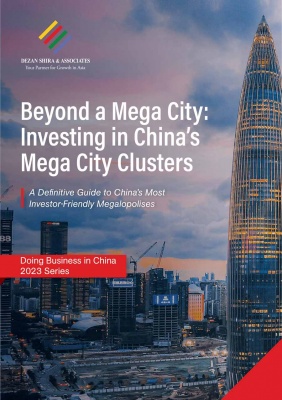
Beyond a Mega City: Investing in China’s Mega City Clusters
Published: August 2023Doing business in China has undergone significant changes in the past few years. With mounting challenges, it is becoming increasingly crucial for executives to stay informed to identify risks in advance and swiftly seize new market opportunities. China’s mega city clusters if one of such concepts that foreign investors cannot miss— the well-established infrastructure, industrial supply chains, and coordinated development strategy of these regions are creating new investment frontiers with unparalleled convenience and advantages. In this definitive guide, we offer a comprehensive introduction to China’s four most significant and investor-friendly metropolises, including the Yangtze River Delta (Shanghai, Suzhou, Hangzhou, etc.), the Pearl River Delta (or the Guangdong-Hong Kong-Macao Greater Bay Area), the Beijing-Tianjin-Hebei (or Jing-Jin-Ji), and the Chengdu-Chongqing Economic Circle.
Doing business in China has undergone significant changes in the past few years. While the country has been a magnet for foreign investment over the last three decades and is expected to remain so in the foreseeable future, businesses operating in China now encounter mounting challenges. These challenges stem from the uneven recovery of China's economy, increasing geopolitical risks, and various internal and external headwinds.
Given this, it is becoming increasingly crucial for executives to stay informed. Only those who align with Beijing's policy priorities and can navigate China's increasingly complex operating environment will be able to identify risks in advance and swiftly seize new market opportunities. In other words, they will be better positioned to not only survive but also thrive in the world's second-largest economy.
Mega city clusters, also known as "megalopolises," are the thrust of China's new urbanization plans and hold immense potential for foreign investment. These geographical concepts emerged in the 1980s, following China's reform and opening up. In the 14th Five Year Plan period (2021-2025), China made a strategic decision to prioritize the development of 19 mega city clusters across the country.
Among them, four mega city clusters—including the Yangtze River Delta, the Pearl River Delta (or the Guangdong-Hong Kong-Macao Greater Bay Area), the Beijing-Tianjin-Hebei (or Jing-Jin-Ji), and the Chengdu-Chongqing Economic Circle—are of paramount importance and are receiving special attention from China for improvement. These four regions, covering just eight percent of China's land, contribute to over 50 percent of the country's economic output and foreign investment. The well-established infrastructure, industrial supply chains, and coordinated development strategy of these regions are creating new investment frontiers with unparalleled convenience and advantages.
Businesses with current operations in China or those considering expansion into this vast market are strongly advised to thoroughly explore and understand the potential of these mega city clusters. In this guide, we offer a comprehensive introduction to the four mega city clusters, encompassing key parameters, such as economic performance, trade statistics, leading industries, preferential policies, and China's developmental plans for each region.
We hope this publication can enable foreign investors to gain a better understanding of the dynamics, priorities, and trends of the Chinese economy and take advantage of the opportunities presented by the next phase of China's urban, industrial, and technological development.
In this guide:
- Part 1: Yangtze River Delta Region
- Part 2: Guangdong-Hong Kong-Macao Greater Bay Area
- Part 3: Jing-Jin-Ji Economic Region
- Part 4: Chengdu-Chongqing Twin City Circle

